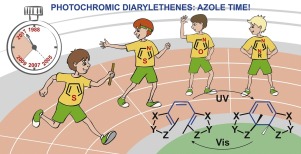Journal of Photochemistry and Photobiology C: Photochemistry Reviews ( IF 12.8 ) Pub Date : 2018-05-05 , DOI: 10.1016/j.jphotochemrev.2018.04.002 Andrey G. Lvov , Marat M. Khusniyarov , Valerii Z. Shirinian

|
For a long time, starting from pioneering works of M. Irie in the late 80 s and early 90 s of the last century, photochromic diarylethenes were primarily associated with dithienylethenes – diarylethenes possessing thiophene groups. However, about 10 years ago, azole heterocycles (thiazole, oxazole, imidazole) started to be used as aryl moieties instead of common thiophenes, which contributed significantly to the development of diarylethene-based photochromes. In this review, we analyzed in detail the effects of substituting traditional thiophenes in diarylethenes by azoles and revealed amazing examples of functional molecules, materials, and devices based on azole-containing photochromic molecules.
中文翻译:

偶氮基双芳烃是迈向高级光致变色材料的下一步
长期以来,从上个世纪80年代末和90年代初M. Irie的开创性工作开始,光致变色二烯基蒽主要与二噻吩基乙烯相关联-具有噻吩基团的二芳基蒽。但是,大约10年前,吡咯杂环(噻唑,恶唑,咪唑)开始用作芳基部分,而不是普通的噻吩,这大大促进了基于二芳基乙烯的光致变色剂的开发。在这篇综述中,我们详细分析了用吡咯取代二噻吩中的传统噻吩的效果,并揭示了基于含吡咯的光致变色分子的功能分子,材料和装置的惊人实例。











































 京公网安备 11010802027423号
京公网安备 11010802027423号